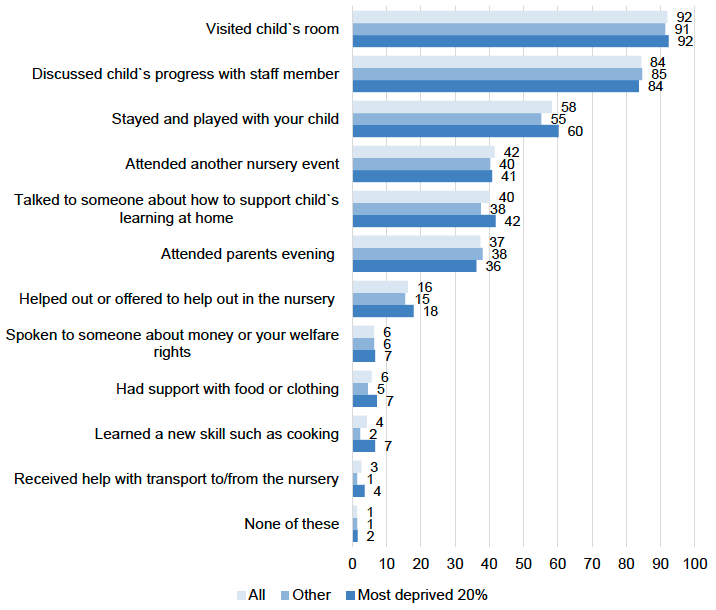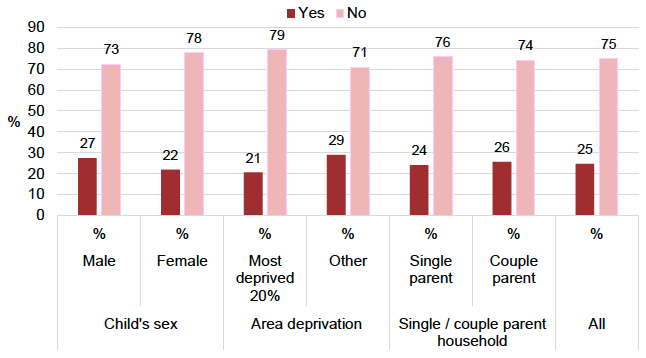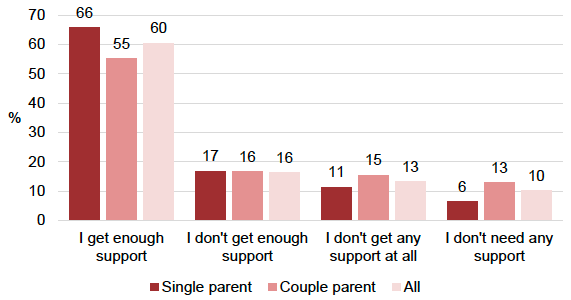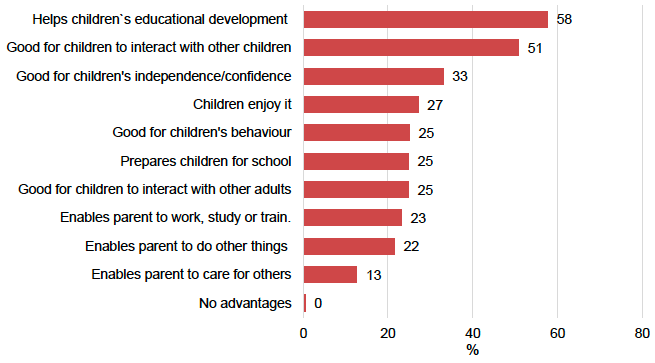Scottish Study of Early Learning and Childcare: Phase 1 Report - Updated 2021
Phase 1 of the Scottish Study of Early Learning and Childcare (SSELC) aimed to gather a robust baseline of child and parent outcomes for a cohort of eligible two-year-olds who were receiving 600 hours of funded early learning and childcare provision.
Use of ELC
Funding, hours attended & accessibility
The parent questionnaire asked about ELC funding and accessibility of childcare. The keyworker questionnaire gathered related information on funded registered hours per week and hours the child attended in the last week.
The full costs of ELC at the setting included in the survey were met for 93% of parents. The remaining 7% paid for some additional hours over and above the 600 hours of funded ELC. A little over three quarters of children had their costs funded through their statutory entitlement (78%), with the remainder being funded through discretionary funding from their local authority. A very small proportion (less than 1%) received some funding from both sources. On average, children were registered for 13.8 hours of funded ELC per week. There was no notable difference in average funded hours taken up by children living in more and less deprived areas. However, some differences were evident in the average hours registered for children funded through their statutory entitlement and those receiving discretionary funding from their local authority, with children funded through their statutory entitlement having slightly longer registered hours on average than those funded through discretionary funding from their local authority (14.2 hours compared with 12.2 hours).
Two-thirds of parents/carers (64%) lived close enough to the ELC setting that a one-way trip from their home to the setting would take less than 10 minutes, while only 1% took 30 minutes or longer to make the trip (Table 1).
Table 1: Average duration of a one-trip journey from home to the setting
| All % |
|
|---|---|
| 0 to 5 minutes |
36 |
| 6 to 10 minutes |
27 |
| 11 to 15 minutes |
18 |
| 16 to 20 minutes |
11 |
| 21 to 30 minutes |
6 |
| More than 30 minutes |
1 |
| Unweighted base |
414 |
Base: All respondents (parent survey)
There were no notable differences in accessibility according to area deprivation (see Table B1 in Appendix B). Some differences were apparent according to urban/rural characteristics with parents living in urban areas more likely than those living in rural areas to live within 10 minutes of their child’s ELC setting (64% compared with 51%)[18].
Engagement with ELC setting
Parents were asked whether they had engaged in any of a range of 11 activities at their child’s ELC setting since the child had started attending. The activities ranged from visiting the child’s room or attending a parent’s evening to speaking to someone about money/welfare rights or learning a new skill such as cooking. As shown in Figure 2, almost all parents (99%) had engaged in at least one of the activities listed. The most common activities were visiting the child’s room (92%) and discussing the child’s progress with a member of staff (84%). Least common were activities such as learning a new skill (4%) and receiving help with transport to and from the nursery (3%).
Figure 2: Activities parent participated in at child’s nursery by area deprivation

Base: All respondents (parent survey)
As the graph also shows, there were some small notable differences in the experiences of parents from more and less deprived areas. Parents living in the most deprived 20% of areas were more likely than those living in other areas to report having stayed and played with their child (60% compared with 55%); talked to someone about how to support their child’s learning at home (42% compared with 38%) and to have learned a new skill such as cooking (7% compared with 2%).
Some variations in engagement are also notable according to parental level of education (see Table B2 in Appendix B). In general, parents whose highest qualification was Higher/Advanced Higher Grade or equivalent were more likely than parents with other qualification levels (both lower and higher) to have undertaken any activity at their child’s nursery. For example, 66% said they had stayed and played with their child compared with 55% of parents with degree level qualifications and 50% of parents with no qualifications. Parents with no qualifications were less likely than those with any qualifications to have attended a parents evening (24% compared with 34% of those with up to National 5s or equivalent) or another type of nursery event (28% compared with 39% of those with up to National 5s or equivalent). However, parents with no qualifications were not consistently less likely to engage in all activities.
Use of other childcare & advantages of child being in nursery
A quarter (25%) of respondents were getting help with childcare on a regular basis from another provider (for example, another nursery, a childminder, or informal care from family or friends). Parents in the most deprived 20% of areas were less likely to do this than those living in less deprived areas, single parent families were less likely to rely on other providers than two parent families and parents of male children were more likely do this than parents of female children. The full breakdown of responses is summarised in Figure 3.
Figure 3: Whether respondent is using other childcare by child’s sex, area deprivation and household type

Base: All respondents (parent survey)
Of the different options available for other childcare (Table 2), the most popular was grandparents (13%) followed by another local authority nursery (4%) and a private or workplace nursery (3%). Table 2 summarises the total results for the other type of childcare used. The majority (77%) of respondents did not use other types of childcare, 15% used one other childcare provider and 8% used two or more. Amongst those who used other childcare providers, on average they did so for 19.4 hours a week. This varied by area deprivation with parents in the 20% most deprived areas reporting higher average weekly hours of additional childcare than those living in other areas (23 compared with 17.5). Parents using ‘unfunded’[19] additional hours did so for an average of 18 hours per week.
Table 2: Other types of childcare used
| All % |
|
|---|---|
| None |
77 |
| Grandparents |
13 |
| Local authority nursery (other than this one) |
4 |
| Ex-spouse |
4 |
| Private or workplace nursery |
3 |
| Childminder |
3 |
| Another relative |
2 |
| Community or voluntary nursery |
1 |
| Unweighted base |
424 |
Base: All respondents (parent survey)
Parents/carers were also asked how they felt about the amount of support they received with childcare from family or friends living outside the household (Figure 4). Most respondents (60%) felt that they received enough support, with more single parents (66%) stating this was the case than those living in two parent households (56%). However, 16% of parents/carers felt they didn’t get enough support and 13% said they got no support at all.
Figure 4: Respondents’ feelings about amount of support received with childcare from family or friends living outside the household by single/couple parent household

Base: All respondents (parent survey)
Finally, parents were asked what the main advantage was when their two-year-old child attends a pre-school or nursery for around 15 hours per week. These responses are summarised in Figure 5[20]. As the graph shows, nursery placements for two-year-olds were recognised as being generally more beneficial for children than for parents. That a placement helped with the child’s educational development was the most popular response with 58% of parents selecting it. No parent stated there were no advantages to a two-year old child being in nursery.
Figure 5: Main advantages of child being in nursery

Base: All respondents (parent survey)
Contact
Email: socialresearch@gov.scot
There is a problem
Thanks for your feedback